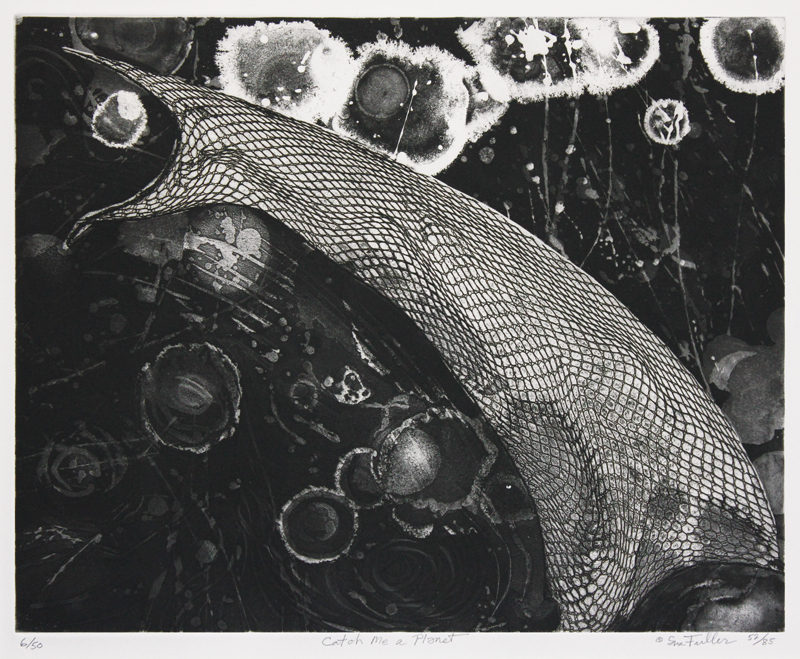
19th, 20th & 21st Century Fine Prints
707-546-7352 · fax 707-546-7924 · web: www.annexgalleries.com · email: artannex@aol.com
Catch Me a Planet by Sue Fuller

Catch Me a Planet
Sue Fuller
Catch Me a Planet
Sue Fuller
1914 - 2006 (biography)Atelier 17 printmaker Sue Fuller was born to an engineer father and a homemaker mother who worked in crochet and knitting. Both parents instilled a love of art in their daughter from an early age, and she pursued a formal education at the Carnegie Institute of Technology. Fuller first worked with Stanley William Hayter at Atelier 17 in New York in 1943, learning experimental techniques in abstract intaglio printmaking after having already established a career as a printmaker and three-dimensional artist. She excelled in these new approaches to the plate, finding inspiration in the ability to manipulate the surface of something that appears otherwise immovable.
"Catch Me a Planet," created in 1952, is a wonderful example of the possibilities of softground technique, with a central component that exhibits a fabric texture expertly pulled into a cylindrical form - a precursor to the crocheted abstract sculptures for which she would later become known. "Catch Me a Planet," while created in the early 1950s, wasn't editioned until 1985. This may have been in part because Fuller, as with many artists, viewed the work as pure experiment when she began working on it in 1952, perhaps not something she was prepared to label as "complete", or more likely because there was virtually no market for abstract work in 1952 and selling work was not a motivation. Yet this vibrant composition, balanced, galactic-like and full of energy, is truly a complete work unto itself. It becomes more relevant as the Webb telescope continues to enlarge our knowledge of the universe and Earth's relationship to it. As well, it stands as a testament to the important contribution of women in 1940s and '50s to American Abstract Expressionism.
In her book "The Women of Atelier 17" author Christina Weyl notes on page 107 about Fuller's use of fabrics to create her prints: "Despite the biased reviews that plagued their soft-ground etchings, Fuller and Atelier 17's other female members were on the cutting edge of twentieth century artists' quest to reassert fiber as a fine art material. They impressed lace, string, and woven textiles into their plates with expressive and modernist intentions."
Sue Fuller was born in Pittsburgh, Pennsylvania on August 11, 1914. Her formal art training began at the Carnegie Institute of Technology. During the summer of 1934 she enrolled in a summer course at the Ernest Thurn School with Hans Hofmann. She graduated from the Institute with her BA in 1936, and then enrolled at the Columbia University's Teachers College where she recieved her MA in 1939.
Fuller traveled throughout Europe in the summer of 1937, where she visited the Degenerate Art Exhibition in Munich. Already a student of Modern art, this would prove to be a source of inspiration despite the intention of the exhibit. In 1943 she worked for the first time with Stanley William Hayter at his famed experiemental workshop, Atelier 17, at the New School in New York, assisting in the printing of prints by artists such as Andre Masson and Marc Chagall; later, she would return as an experimental artist in her own right.
The following year she took a job as an art teacher for children at the Museum of Modern Art and studied design with Josef Albers. He introduced her to experimental weaving, the fundamentals of which would cross over into her printmaking techniques. While working at Atelier 17, Fuller experimented with adding textures to the soft grounds of her intaglio plates. In 1944, she was an exhibitioner in MOMA's "Hayter and Studio 17: New Directions in Gravure," and in 1949, having established a name independent of her teachers', she was given a show of her three-dimensional weavings and experimental, abstract lace-making constructions at the Bertha Schaefer Gallery. She would continue to be represented by the gallery until the late 1960s.
Fuller continued to experiment with a variety of mediums, including glassmaking and calligraphy, and she had an extensive and prolific exhibitioning career, paving the way for more women artists in the male-dominated Abstract field. Sue Fuller died in Southampton, New York on April 19, 2006.


